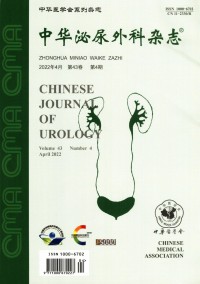Condition assessment and treatment strategy selection for patients with renal cell carcinoma bone metastasis
Q4 Medicine
引用次数: 0
Abstract
Objective To investigate the assessment and treatment strategy of patients with renal cell carcinoma. Methods The clinical data of 43 patients with renal cell carcinoma and bone metastases admitted to the First Affiliated Hospital of Nanjing Medical University from January 2006 to December 2018 were retrospectively analyzed. The follow-up time was 6 years, with an average age of 55.4 years (21-87 years). There were 29 males, 14 females, 22 cases of limb bone metastasis, 12 cases of spinal metastasis, 9 cases of multiple bone metastasis, 21 cases of Fuhrman grade 1 and 2, 19 cases of T1, and 20 cases of N0. All patients were confirmed by postoperative pathological examination or imaging data suggesting that bone metastasis are from renal cell carcinoma. Forty-three patients underwent primary renal surgery, and molecular targeted therapy was used after the operation. The treatment process was smooth, no obvious discomfort, and postoperative pathology showed clear cell carcinoma.22 patients with limb bones metastasis and 12 patients with spinal metastasis included in the study all met the indications for secondary surgery after the disease assessment. After communicating with the patient, 13 patients with limbs metastasis and 6 patients with spinal metastasis received local treatment, including complete resection of the extremities and spinal fixation, the remaining 15 patients and 9 patients with multiple bone metastasis were treated conservatively. There were 19 patients in the local treatment group, 13 patients with limbs bone metastasis, 6 patients with spinal bone metastasis, the average age was 54.9 years, the average diameter of the primary tumor was 4.7 cm. There were 24 patients in the conservative treatment group, 9 patients with limbs metastasis, 6 patients with spinal metastases and 9 cases with multiple bone metastasis, with an average age of 56 years and a primary tumor diameter of 5.6 cm. Limb metastatic lesions were evaluated according to the patient's general condition, bone pain, fracture risk, and bone metastasis. Spinal lesions were evaluated according to Tokuhashi score, Harrington score, Tomita score, vertebral stability assessment, and molecular targeted therapy. Aminokinase inhibitors, conservative treatment with local radiotherapy and bisphosphonate treatment. Results During the follow-up period, the 1-year overall survival rate of the local treatment group was 100.0%, the 2-year overall survival rate was 89.4%, and the 5-year overall survival rate was 73.7%. The 1-year overall survival rate of the conservative treatment group was 87.5%, and the 2-year overall survival rate was 62.5%. The 5-year overall survival rate was 16.7%. The 2-year and 5-year survival rates of the local treatment group were statistically different (P=0.044, P=0.000) compared with the conservative treatment group. For patients with limb bone metastasis, the 5-year survival rate was significantly higher in patients receiving topical treatment than in the conservative treatment group (P=0.011). For spinal metastasis, spinal pain in the local treatment group was alleviated to varying degrees. No spinal instability and spasticity were observed after follow-up. In the spine patients who received conservative treatment, 3 patients developed paraplegia, which was statistically different from local treatment (P=0.046). Another 9 patients with multiple bone metastases did not undergo local surgery, and all died after multiple organ failure. Conclusions At the same time of molecular targeted therapy, according to the evaluation results, selective treatment of bone metastases with secondary surgical indications, including complete resection of the extremities and spinal fixation, can significantly improve the survival and quality of life of those patients. Key words: Carcinoma, renal cell; Bone metastasis; Condition evaluation; Treatment strategy; Complete resection; Spine fixation肾细胞癌骨转移患者的病情评估及治疗策略选择
目的探讨肾细胞癌患者的评估及治疗策略。方法回顾性分析南京医科大学附属第一医院2006年1月至2018年12月收治的43例肾细胞癌骨转移患者的临床资料。随访时间6年,平均年龄55.4岁(21-87岁)。其中男性29例,女性14例,四肢骨转移22例,脊柱转移12例,多发性骨转移9例,富尔曼1级和2级21例,T1 19例,N0 20例。所有患者均通过术后病理检查或影像学数据证实骨转移来自肾细胞癌。43名患者接受了原发性肾脏手术,术后采用分子靶向治疗。治疗过程顺利,无明显不适,术后病理显示透明细胞癌。纳入研究的22例四肢骨转移患者和12例脊柱转移患者在疾病评估后均符合二次手术的指征。与患者沟通后,13例四肢转移患者和6例脊柱转移患者接受了局部治疗,包括四肢完全切除和脊柱固定,其余15例和9例多发性骨转移患者接受保守治疗。局部治疗组19例,四肢骨转移13例,脊椎骨转移6例,平均年龄54.9岁,原发肿瘤平均直径4.7cm。保守治疗组24例,四肢转移9例,脊椎转移6例和多发性骨转移9例,平均年龄56岁,原发肿瘤直径5.6厘米。根据患者的一般情况、骨痛、骨折风险和骨转移评估四肢转移性病变。根据Tokuhashi评分、Harrington评分、Tomita评分、脊椎稳定性评估和分子靶向治疗对脊柱病变进行评估。氨基激酶抑制剂,局部放疗保守治疗和双磷酸盐治疗。结果在随访期间,局部治疗组1年总生存率为100.0%,2年总存活率为89.4%,5年总成活率为73.7%,局部治疗组的2年和5年生存率与保守治疗组相比有统计学差异(P=0.044,P=0.000)。对于四肢骨转移患者,接受局部治疗的患者的5年生存率显著高于保守治疗组(P=0.011)。对于脊柱转移,局部治疗组的脊柱疼痛得到不同程度的缓解。随访后未观察到脊柱不稳定和痉挛。在接受保守治疗的脊柱患者中,3名患者出现截瘫,与局部治疗有统计学差异(P=0.046)。另有9名多发性骨转移患者未进行局部手术,均死于多器官衰竭。结论在分子靶向治疗的同时,根据评估结果,对骨转移瘤进行二级手术指征的选择性治疗,包括四肢完全切除和脊柱固定,可以显著提高患者的生存率和生活质量。关键词:癌,肾细胞;骨转移;条件评估;治疗策略;完全切除;脊柱固定
本文章由计算机程序翻译,如有差异,请以英文原文为准。
求助全文
约1分钟内获得全文
求助全文
来源期刊

中华泌尿外科杂志
Medicine-Nephrology
CiteScore
0.10
自引率
0.00%
发文量
14180
期刊介绍:
Chinese Journal of Urology (monthly) was founded in 1980. It is a publicly issued academic journal supervised by the China Association for Science and Technology and sponsored by the Chinese Medical Association. It mainly publishes original research papers, reviews and comments in this field. This journal mainly reports on the latest scientific research results and clinical diagnosis and treatment experience in the professional field of urology at home and abroad, as well as basic theoretical research results closely related to clinical practice.
The journal has columns such as treatises, abstracts of treatises, experimental studies, case reports, experience exchanges, reviews, reviews, lectures, etc.
Chinese Journal of Urology has been included in well-known databases such as Peking University Journal (Chinese Journal of Humanities and Social Sciences), CSCD Chinese Science Citation Database Source Journal (including extended version), and also included in American Chemical Abstracts (CA). The journal has been rated as a quality journal by the Association for Science and Technology and as an excellent journal by the Chinese Medical Association.
 求助内容:
求助内容: 应助结果提醒方式:
应助结果提醒方式:


